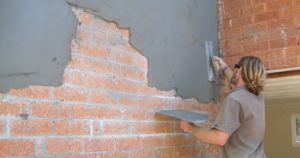Mortar types and uses
MORTAR
Mortar may be defined as a paste formed by mixing binding material, fine aggregate and water in specific proportions. This paste hardens on drying and binds the bricks, stones or concrete blocks together.
USES OF MORTAR
i) It is used in masonry to bind stones, bricks or concrete blocks together.
ii) It provides an even bed to stones, bricks or concrete blocks and prevents their inequalities from bearing upon one another.
iii) It is used for pointing the joints of masonry or for plastering the surface of masonry to protect it from weather and to give the work a pleasing and smooth finish.
iv) In concrete it is used to bind the particles of coarse aggregate into one solid mass.
TYPES OF MORTAR
Different mortars that may be used are: (i) Lime mortars, (ii) Cement mortar, and (iii) Lime cement or Composite mortars.
LIME MORTARS
- Lime mortar may be lime and sand mortar or lime and surkhi mortar or lime, sand and surkhi mortar or lime and cinder mortar (black mortar).
- Slaked fat lime is used to prepare mortar for plastering and hydraulic lime in preparing mortar for masonry construction.

LIME CEMENT MORTAR
It is also known as composite mortar. When lime mortar made from fat lime is desired to be improved with regard to its initial setting time then cement is added to it. Cement should be added only to that much lime mortar which can be used within two hours of the addition of cement
CEMENT MORTAR
It is far stronger than lime mortar and is, therefore, preferred for use in the construction of structures subjected to heavier loads. When small quantities of it are required then it is prepared manually. In case the requirements are large then it is mixed mechanically in mixers.
PRECAUTIONS IN THE USE OF MORTARS
Following precautions in the use of mortars should be considered.
1- All mortars prepared for masonry works shall be used as soon as possible with the maximum limits given below:
a) If hydraulic lime (Class A lime) is present in mortar as an ingredient, the mortar shall be used within four hours.
b) Lime mortar made with surkhi or cinder shall be used within 24 hours of grinding.
c) Composite mortars shall be used within two hours of the addition of cement.
d) Cement mortar shall be used within 90 minutes after adding water.
2- All lime mortars, after grinding shall be kept wet and shall never be allowed to dry. This may be done by covering ground mortar with wet sacks.
3- Partly set and dried mortar should not be retempered and used.
4- All masonry using lime mortar shall be cured for a period of six days. Whereas cement mortar is kept wet for little longer periods.
5- In case of masonry works with lime mortars, it is desirable that masonry, after a height of every 1.5 metre, shall be allowed to set for about two days before starting further construction over it.
6- Hydraulic limes and cements set and become hard in the presence of water. Bricks which are porous absorb greater part of water from the mortar (thus the mortar becomes weak). Bricks should be fully saturated with water before laying them in the structure.
FIRE RESISTANT MORTAR
Commonly used lime and cement mortar are unsuitable for setting refractory bricks or blocks used for the lining of furnaces where the temperatures are too high for these mortars. At such high temperatures these mortars fail due to shrinkage and cracking.
USE OF CEMENT SAND MORTAR

Click To See All Construction Material Notes
Mortar types and uses, Mortar types and uses, Mortar types and uses, Mortar types and uses, Mortar types and uses, Mortar types and uses, Mortar types and uses, Mortar types and uses, Mortar types and uses, Mortar types and uses, Mortar types and uses, Mortar types and uses, Mortar types and uses, Mortar types and uses, Mortar types and uses, Mortar types and uses,

please help me with .
what are the grades of mortar .
types of morter with there uses in various sector.
thank you.
http://civilengineerspk.com/bsc-civil-engineering/construction-materials/